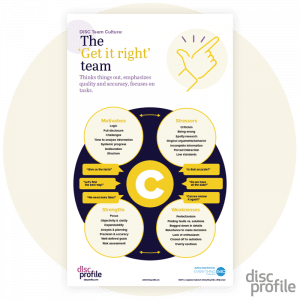Group culture is not simply the average of all the people in the group. A number of different factors determine group culture, such as:
- the style of the group leaders
- the most pronounced styles within the group
- the type of work the group does
- the historical culture of the group
- the cohesion or tension within the group
- the goals and mission of the group
When a team displays a C culture it values high standards, careful analysis, and diplomacy. It might shy away from new ideas.
The C culture rewards
- accuracy
- completeness
- attention to detail
- on-time performance
- dependability
The C culture criticizes
- mistakes
- illogical behavior
- lateness
- spotty research
- exaggeration
Advantages of the C culture
- calculates risks thoroughly
- delivers exceptional quality control
- makes decisions logically
- ensures accuracy
- clarifies policies and expectations
- emphasizes reliability and precision
- respects people’s rights
- provides well-defined goals
Drawbacks of the C culture
- overanalyzes
- misses opportunities due to excess caution
- lacks outward excitement and energy
- stifles informal communication
- fails to foster a strong sense of community
- ignores people’s feelings
- feels critical, cold, or cynical to some
- closes itself off to outsiders
Since I’m a CD, all this sounds great. But having worked in a C culture I know how easy it is to be seen as cold, critical, and hard to approach. It’s also hard to take chances or take actions to energize the group.
Your thoughts?
How do you respond to the C culture? How can a C team be more decisive? How would you lead a C team? What can you learn from the C culture?
Download the “Get it right” team poster (PDF)
Learn more
A group report is available for the Everything DiSC® Workplace, Agile EQ, Productive Conflict, Management, and Sales profiles.


